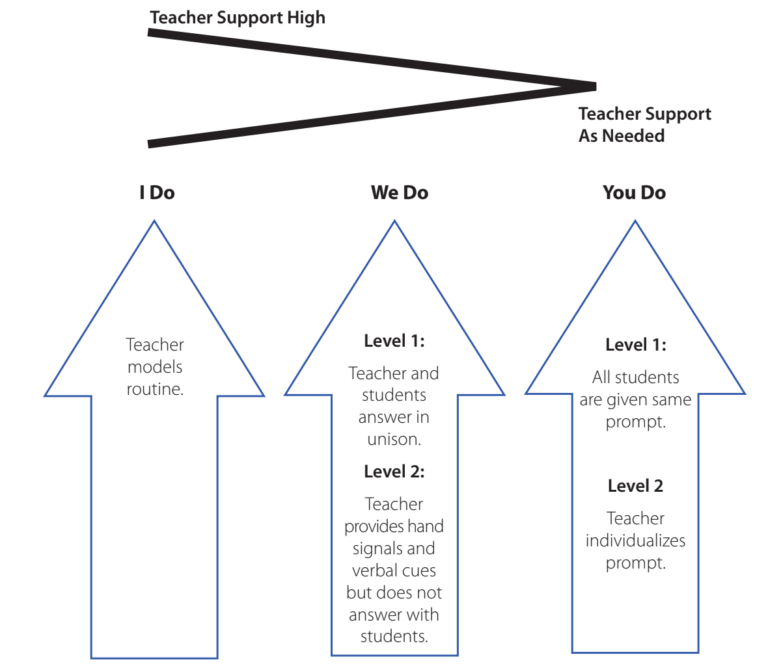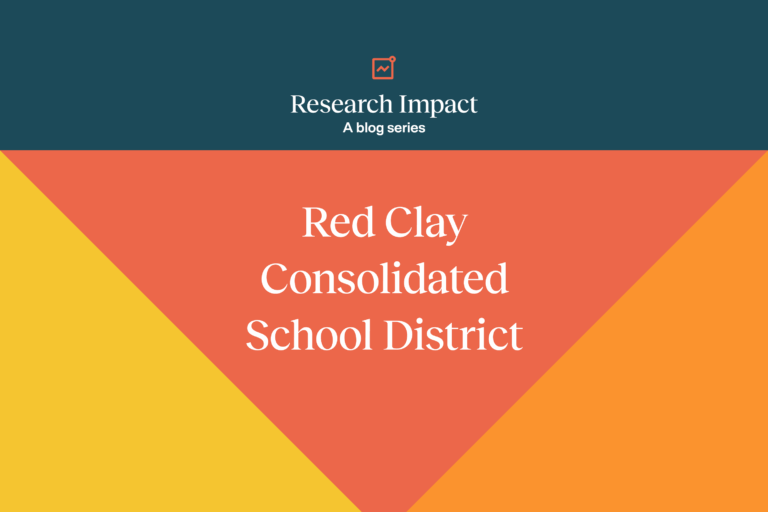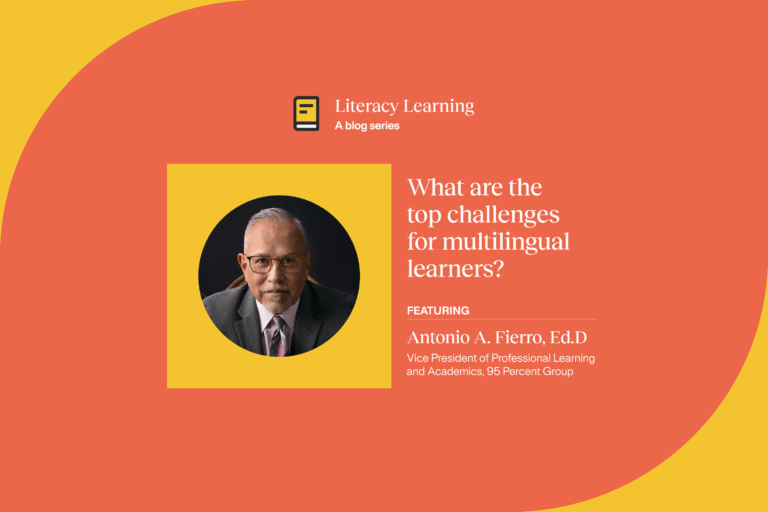Advanced phonics and multisyllable routines
95 Percent Group believes that every child should have equal opportunities to learn how to read, regardless of age or grade level. Multisyllable Routine Cards (MSRC) can help. The product is based upon expert knowledge in the science of reading and learning sciences.

While only 32% of fourth-grade students were considered “proficient” or above in reading (NAEP, 2022), projections from early reading assessments show that students’ phonics skills learned in grades 1–3 are not recovering from the pandemic at the needed rate. The problem is evident: the shift from “learning to read” to “reading to learn” in upper elementary school proves difficult for those who lack a strong reading foundation. Poor readers face deficits in phonological processing that affect their decoding skills, which is the primary challenge in upper elementary grades (Toste et. al., 2017). As students progress from grade to grade, they encounter richer and more complex words that are crucial to their understanding, but struggling readers are slowly left behind without the tools and strategies to decode what’s on the page.
“Reading can be a challenge for older students. A lot of our students who get to these upper grades start making poor decisions, because they can’t do what everyone else can do, yet. When they are finally able to access the same knowledge [as their classmates] they feel like they’re part of the learning community. They start loving reading again,” said Laura Robinson, an instructional coach at Vickery Mill Elementary School.
That’s where Multisyllable Routine Cards (MSRC) fit in. 95 Percent Group believes that every child should have equal opportunities to learn how to read, regardless of age or grade level. The product is based upon expert knowledge in the science of reading and learning sciences. It is also evidence-based, which ensures students have effective tools for decoding multisyllabic words. This curriculum can be utilized five minutes a day as a whole class supplement to the core literacy instruction. It can also be reinforced in small groups after whole class instruction or as an intervention with small groups when fewer students need this instruction. And it works. Independent efficacy studies demonstrated a 73% increase in 4th graders on or above benchmark after one year of using 95 MSRC, and a 65% increase for 5th graders.
Explicit instruction: Multisyllable routines
Multisyllable Routine Cards are designed for students in third grade and above as a fast-track approach to help students who are stumbling on multisyllable words. These time-efficient routines utilize explicit and direct phonics instruction to help students who could improve their skills in decoding longer words. Research shows that systematic and explicit instruction is more effective than unsystematic or no phonics instruction (Hansford & King, 2022). This program’s flexibility allows teachers from a variety of subjects to build students’ academic vocabulary and improve students’ reading skills. With MSRC, upper elementary and middle school educators have agency in their own learning. This program equips them with the knowledge and strategies of six syllable types and division patterns through a prescribed three-step process:
- Recognize the syllable type: students learn and recognize patterns, making gestures to demonstrate their knowledge and reinforce new concepts. Students sort single-syllable words until they develop fluency in recognizing the pattern of consonants and vowels of the particular syllable type.
- Read the syllable type: the focus shifts to accurate and fluent reading of the syllable. The students apply their fluent recognition of the syllable type to produce the correct vowel sound that applies to each syllable type and then blend and read the syllable.
- Read the multisyllable word: the purpose shifts to applying recognition and vowel sound pronunciation to reading two-syllable pseudowords and words that appear in text. In Step 3, students receive instruction on proper techniques for syllable division. The Multisyllable Routine Cards are designed to be used as a five-minute supplement to whole-class instruction or while working with small groups of students who need extra support.
Multimodal, multi-tier instruction
With flexibility to work across tiers of instruction, MSRC provides multisensory learning directly in the lessons through using gestures and manipulatives. Making education multisensory helps encourage deeper learning, benefiting students most in need. For example, students with dyslexia need more opportunities to develop “adequate and automatic integration of letters and speech sounds” (Blomert & Froyen, 2010). In the MSRC curriculum, multiple senses reinforce concepts. Students can strengthen their new learning and apply new concepts through repeated exposure to all the sensory pathways. Vaughn and Linan-Thompson believe preventive and remedial instruction must be substantially more intense than regular classroom instruction to accomplish its purposes (2003). One study demonstrates this idea; researchers conducted reading interventions amongst high school students with learning disabilities. The study showed substantial gains after intense reading interventions through systematic phonics and word-based systems compared to those who did not receive such interventions (Giess et al., 2012). Multimodal instruction is utilized within the MSRC lessons, as students use multiple modalities to engage all five senses when learning phonics. Students see the letters (visual) and hear the teacher segmenting words into individual sounds (auditory). Throughout the lesson, students make gestures, move their pencils when writing and sorting words in boxes for kinesthetic learning, and feel the pencil as they write to stimulate tactile learning. These tools help students visualize abstract concepts, making the learning process more concrete.
Guided practice
95 Percent Group employs guided practice through Gradual Release of Responsibility (GRR), first introduced by Pearson and Gallagher to provide differentiated instruction for all students. The purpose of Gradual Release is to slowly pull away scaffolds in a way that makes all students feel successful. During the “I Do” phase, the teacher explicitly teaches the new skill through think-alouds, requiring no response from students. As students launch into structured practice with the teacher in the “We Do” phase, it is divided into two levels. Level one allows for the teacher and students to answer. The teacher invites students to work with them as the teacher manipulates the materials and answers with the students. Level two requires only the students to answer. The teacher continues to lead the activity while manipulating the materials, but only the students respond. Finally, in the last phase, “You Do,” students demonstrate skill mastery through practice activities using handouts, manipulatives, or oral cues. Employing this strategy, the “We Do” and “You Do” allows educators to provide immediate and corrective feedback to students (Rosenshine, 2012). As students move through the I Do, We Do, and You Do process and gain mastery of a specific skill through practice, the amount of scaffolding or support decreases, as shown below. The teacher monitors and adjusts the level of support according to the students’ needs.

Digital files and interactive literacy instruction
95 Percent Group is deeply committed to offering products that are backed by scientific research. Each curriculum is guided by research-based routines and digital, animated files to ensure the highest instructional quality. Digital files are simple, but powerful. When this piece of technology is combined with the science of reading and learning, it creates a truly unique and engaging experience for teachers and students. Utilizing interactive learning strategies like call and response, gestures, and manipulatives motivates students and fosters a more positive learning environment than those in traditional classrooms (Javed & Odhabi, 2018). This technology in tandem with interactive learning strategies helps to keep everyone on track and ensures that instruction is consistent, effective, and fun.
Related resources
Multisyllable Routine Cards (MSRC) empower educators through perky paced routines, interactive digital files, and evidence-based and research-aligned strategies.
- To read a recent ESSA Level 3 study conducted on MSRC in Wicomico, Maryland, download the efficacy study.
- For more information on how to develop your students’ phonics skills, download our 95 Phonics Continuum.
Learn more
95 Percent Group’s evidence-based solutions are proven to be highly effective in promoting literacy skills and academic achievement through the power of reading sciences. By using instructional strategies and materials that have been backed by studies, you can give your students the best possible education and set them up for success in reading and beyond. After completing Multisyllable Routine Cards, students will be able to decode words with confidence and read with accuracy; moreover, they’ll also have a stronger foundation for success in school and in life. Multisyllable Routine Cards is a system that proves, regardless of age, it is never too late to give students the tools they need to succeed. Learn more.
Sources:
Blomert, L., & Froyen, D. (2010). Multi-sensory learning and learning to read. International journal of psychophysiology, 77(3), 195-204.
Ehri, L. C., Nunes, S. R., Stahl, S. A., & Willows, D. M. (2001). Systematic phonics instruction helps students learn to read: Evidence from the National Reading Panel’s meta-analysis. Review of Educational Research, 71(3), 393–447. https://doi.org/10.3102/00346543071003393
Giess, S., Rivers, K. O., Kennedy, K., & Lombardino, L. J. (2012). Effects of Multisensory Phonics-Based Training on the Word Recognition and Spelling Skills of Adolescents with Reading Disabilities. International Journal of Special Education, 27(1), 60-73.
Hansford, N., King, J. (2022). A Meta-Analysis of Language Programs. Teaching By Science. https://www.teachingbyscience.com/a-meta-analysis-of-language-programs?fbclid=IwAR20B5MDdrLFdsyAQSD0j049jtZUsyw94qKTSwxmUWB4dCwyqNakt3HxVqw
Javed, Y. & Odhabi, H. Active Learning in Classrooms Using Online Tools: Evaluating Pear-Deck for Students’ Engagement. (2018). Fifth HCT Information Technology Trends (ITT), 2018, pp. 126-131, doi: 10.1109/CTIT.2018.8649515.
The Nation’s Report Card. (2022). NAEP report card: Reading. State Achievement-Level Results. https://www.nationsreportcard.gov/reading/states/achievement/?grade=4
National Reading Panel (U.S.) & National Institute of Child Health and Human Development (U.S.). (2000). Report of the National Reading Panel: Teaching children to read: an evidence-based assessment of the scientific research literature on reading and its implications for reading instruction. U.S. Dept. of Health and Human Services, Public Health Service, National Institutes of Health, National Institute of Child Health and Human Development.
Toste, J. R., Williams, K. J., & Capin, P. (2017). Reading big words: Instructional practices to promote multisyllabic word reading fluency. Intervention in School and Clinic, 52(5), 270-278.
Vaughn, S., & Linan-Thompson, S. (2003). What is special about special education for students with learning disabilities? The Journal of Special Education, 37(3), 140-147.



